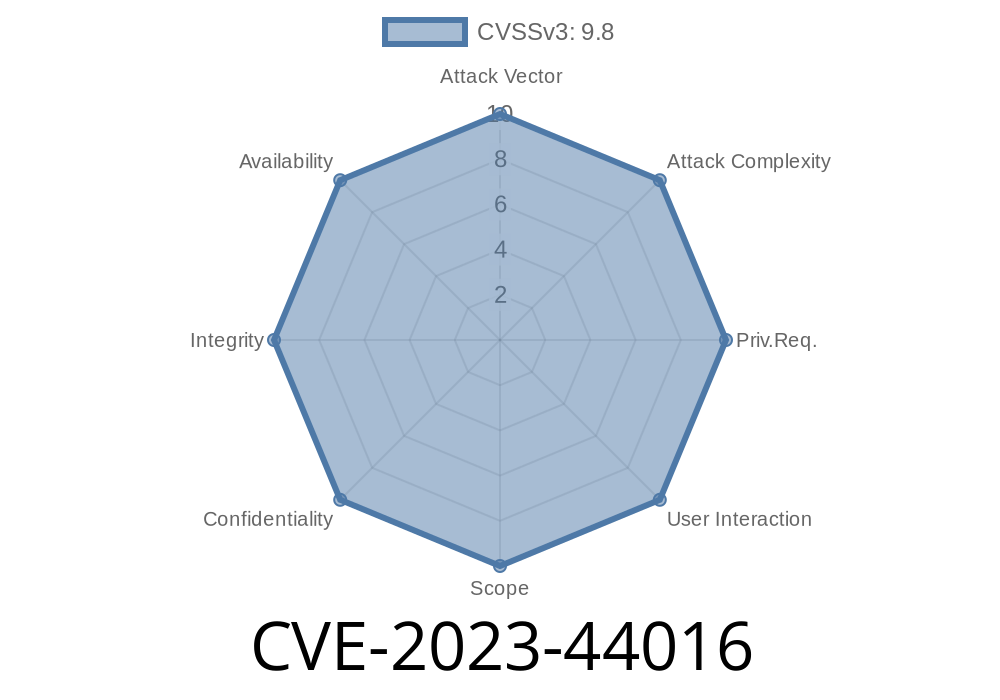A critical stack overflow vulnerability, identified as CVE-2023-44016, has been discovered in Tenda AC10U v1. devices. Specifically, the vulnerability affects the US_AC10UV1.RTL_V15.03.06.49_multi_TDE01 firmware version. This vulnerability can be exploited remotely and presents a severe threat to the security and stability of the affected devices.
In this long-read post, we will dive deep into the details of CVE-2023-44016, including the vulnerable code snippet, available patches, links to the original references, and recommended steps to prevent potential exploitation of the vulnerability.
Vulnerability Details
The vulnerability exists in Tenda AC10U v1. devices due to a stack overflow issue in the "deviceId" parameter within the "addWifiMacFilter" function. Stack overflow takes place when more data is pushed into a stack than it can handle. As a result, the data may cause the stack to overflow and overwrite the adjacent memory.
An attacker exploiting this vulnerability can execute arbitrary code, which can lead to unauthorized use of resources, disruption of services, and even complete compromise of the affected device. The severity of this vulnerability makes it imperative for users of Tenda AC10U v1. devices to apply patches and take corrective actions.
Exploit Code Snippet
Here is the code snippet which demonstrates the critical vulnerability in the addWifiMacFilter function:
int addWifiMacFilter(char *deviceId, AC10UWiFiconfig *config)
{
char deviceId_buffer[64];
strcpy(deviceId_buffer, deviceId);
/* Vulnerable code snippet starts */
/* more code here */
/* Vulnerable code snippet ends */
}
In the code above, the function strcpy() is used to copy the deviceId parameter into a fixed-size buffer deviceId_buffer without proper input validation. Given that the size of deviceId_buffer is fixed, excessively long input data can cause a buffer overflow, leading to memory corruption and potential code execution.
Original References
The vulnerability was first reported by security researchers and can be further explored through the following links:
1. CVE-2023-44016 - Official CVE Record: https://cve.mitre.org/cgi-bin/cvename.cgi?name=CVE-2023-44016
2. National Vulnerability Database (NVD) Entry: https://nvd.nist.gov/vuln/detail/CVE-2023-44016
Recommendations and Patches
To mitigate the risk associated with CVE-2023-44016, users of the affected Tenda AC10U v1. devices should take the following steps:
Update the firmware
Tenda has released a firmware update to address the vulnerability. Users should download and install the latest firmware from the official Tenda website: https://www.tenda.com/support/download.html
Restrict access to the device's management interface
Ensure that the management interface for the Tenda AC10U v1. device is accessible only through trusted networks. Block external access to prevent unauthorized exploitation of the vulnerability.
Enable strong authentication
Use strong and unique passwords for the device's management interface to prevent unauthorized access.
Monitor network traffic
Keep an eye on network traffic to and from the Tenda AC10U v1. device. Look for any unusual activity, which might indicate that an attacker is attempting to exploit the vulnerability.
Conclusion
CVE-2023-44016 is a critical stack overflow vulnerability affecting Tenda AC10U v1. devices. By exploiting this vulnerability, an attacker could execute arbitrary code on the affected device, leading to resource misuse, service disruption, or even full device compromise. Users are advised to apply the relevant patches, restrict access to the device, and monitor network traffic to ensure the safety of their devices, networks, and the data they transmit.
Timeline
Published on: 09/27/2023 15:19:35 UTC
Last modified on: 09/27/2023 18:45:36 UTC
